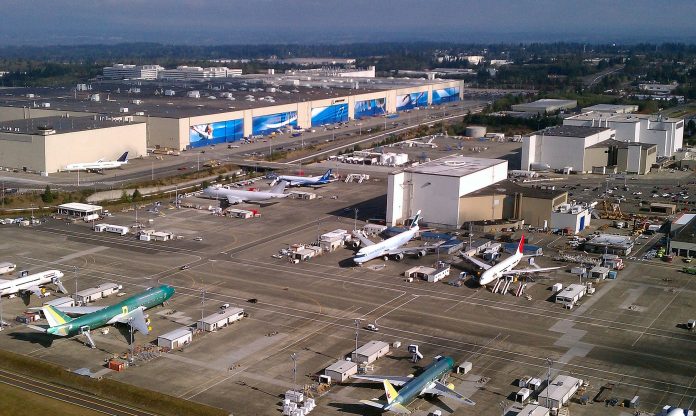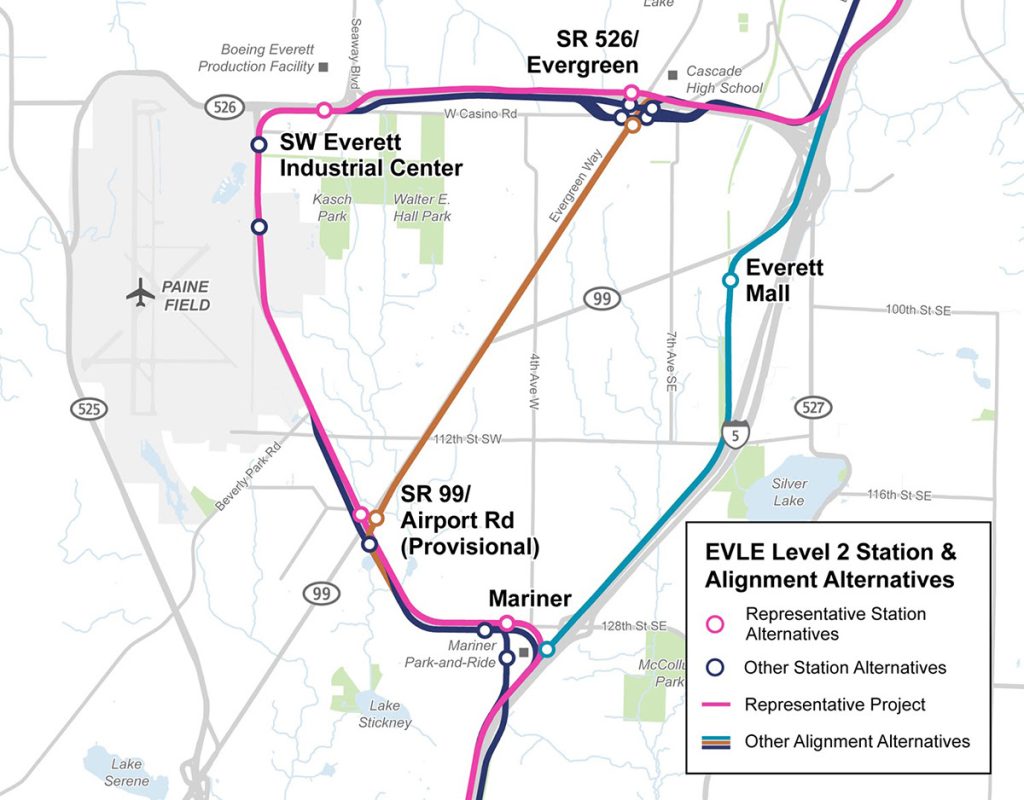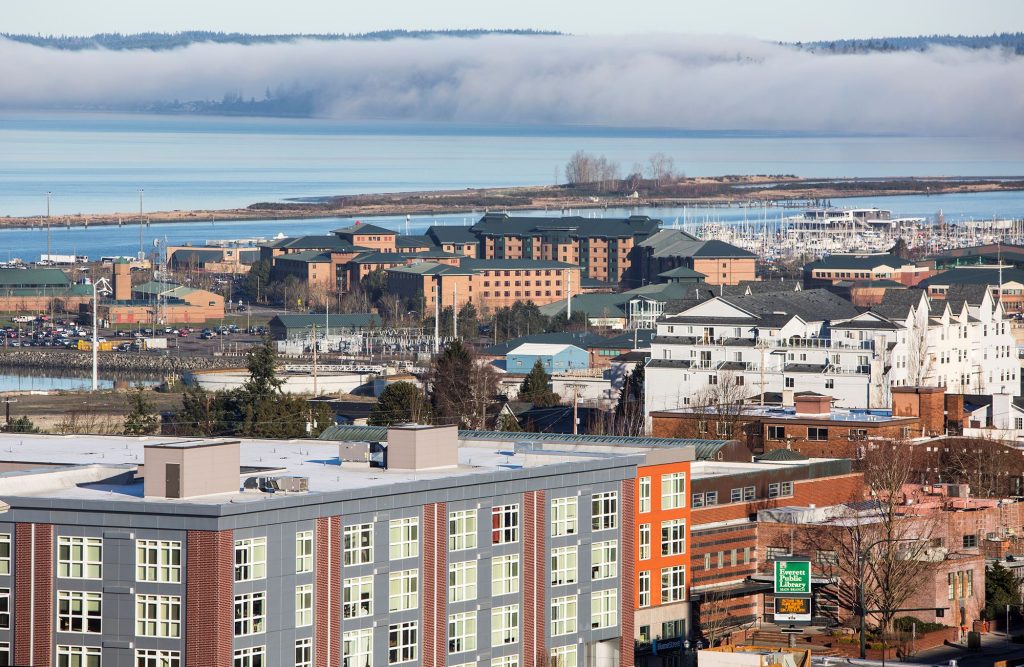
County Executive Dave Somers steamrolled opposition and led a vote to make a longer, more expensive routing to Boeing and Paine Field the only Everett Link option.
In June, The Urbanist reported that Sound Transit had added two new alternatives to its study of the Everett Link light rail extension options, hoping the more direct routes might offer options that could open sooner due to their lower expected cost. On Wednesday, the Elected Leadership Group (ELG) charged to represent Snohomish County residents voted to summarily remove the SR 99/Evergreen Way and I-5 alternatives from consideration before any in-depth study could be done.
Snohomish County Executive Dave Somers argued that most of the opposition to the alignment was coming from King County and implied there was almost no valid criticism from his own constituents.
“The idea of greatly cutting back the Snohomish County portion of the Sound Transit system is quite maddening and offensive,” Somers said at the meeting. “We’re spending time and energy fighting amongst ourselves, and it really needs to stop here, and I’m going to recommend we pull the SR 99 and I-5 alignments. If we keep those two options alive, we’re going to talk about shrinking our system to the benefit of folks south of the border, frankly.”
Snohomish County Councilmember Megan Dunn, whose District 2 includes most of the Everett Link project area, saw it differently and was the only ELG member against Somers’ motion in an acclamation vote that decided the fate of Everett Link.
“It’s really critical that we’re allowing communities to speak for themselves, and I’m hearing from residents in Everett and in this area that are opposing this idea and would like more information,” Dunn said. “We need the data and the studies which shows which option is best. Which one has the best ridership? Which one has the best dollars per mile? Which one has the biggest impact on climate change?”
Barring pushback from the Federal Transit Administration or some sort of tectonic shift in local politics, the ELG’s voice vote appears to assure that the Paine Field routing will be a reality, locking in place multi-billion-dollar transportation infrastructure for many generations to come without seriously studying alternative alignments that may perform better.
A petition that The Urbanist’s Stephen Fesler circulated earlier this week garnered more than 400 signatures and appeared to get leaders’ attention. Executive Somers issued a point-by-point rebuttal, dismissing any merit to the arguments and calling it propaganda from the outside. (Fesler worked for Snohomish County as a land use planner for seven years and was involved in the Everett Link planning process, for what it’s worth.)
“I’d be really wary of a propaganda campaign, and that’s what I believe it is, from an organization that’s really based in Seattle and King County,” Somers said, referring obliquely to The Urbanist. “[They’re] recommending we chop our portion of the Sound Transit 3 package while that same organization is always advocating for expansion and addition of expensive bells and whistles in their portion of Sound Transit 3 program.”
Rather than trying to short Snohomish County, Fesler’s editorial recommended adding infill stations to the alternative alignments better suited to transit-oriented development and walkable urbanism.
“As for potential infill station locations for the alternative alignments, obvious ones include 112th Street SW/SR 99, SW Everett Mall Way/SR 99, 4th Avenue W/SR 99, 112th Street SE/I-5, and Beverly Boulevard/I-5,” he wrote. The first three would pair with the SR-99 alignment and the latter two with I-5. Adding two infill stations with the Evergreen Way alignment would net more stations for Snohomish County than Paine Field does, and the savings from the more direct route may actually allow the expanded project to happen on time and on budget. Fesler also recommended a variety of other related investments, such as additional bus rapid transit, new pedestrian and bike facilities, and mitigation for community impacts.
Under the Somers-led plan, future light rail riders coming from Downtown Everett or Evergreen will take a time-consuming detour to Paine Field on their way to the Mariner neighborhood, Lynnwood, and points south. Granted, riders headed to the Boeing complex, the Paine Field airport, or surrounding industrial parks may find the detour useful. But for other riders, it means adding four to seven minutes to their trip each way compared to the removed alternatives given the circuitousness of the route — time that adds up over the course of a transit rider’s life.
Everett City Councilmember Ben Zarlingo (District 5), who serves on the ELG, said he didn’t want Everett to be a bedroom community for Seattle, dismissing the extra time that looping over toward Boeing will cost riders, whether headed to Seattle or simply next door to Lynnwood. Everett Mayor Cassie Franklin seemed to agree, but also said she wanted to attract Seattle and King County residents to ride light rail to work in Everett, such as in the hospitals down. The slower route would seem to decrease that likelihood.
Since they’re shorter and more direct, the Evergreen Way and I-5 alternatives are expected to be significantly less expensive than the Paine Field alignment, and that makes them more likely to be delivered by the targeted opening date of 2037. Meanwhile, Sound Transit has warned cost escalations are putting the Paine Field project at risk of delay.

Public comment included considerable support for studying the full set of options before jumping into such a monumental decision. Likewise, several members of Sound Transit’s formal Community Advisory Group (CAG) and several Everett City Councilmembers urged the agency to study all three alignments so they could make informed decisions and allow the advisory bodies to fulfill their duties to vet the project. Those pleas were not heeded.
In squashing the alternatives, Executive Somers repeatedly said allowing different options to be studied would “butcher” the Sound Transit 3 (ST3) plan that voters backed in 2016 and dismissed any advantages those alternatives might offer. Everett Mayor Franklin and Lynnwood Mayor Christine Frizzell expressed similar sentiments and have sharply rebuked Sound Transit officials for considering the idea, which they painted as disruptive and sprung on them unexpectedly. (The Urbanist did report on the proposal in June.)
| Metric | SR 99 Alignment | I-5 Alignment | Paine Field Alignment |
| Number of Stations** | 3 | 2 | 4* |
| Miles of Track | 5 | 3 | 6.75 |
| Travel Time | 8.5 minutes | 5 minutes | 12 minutes |
| Operations and Maintenance Facility Options | 2: SR 99/Gibson Road and 164th Street SE/I-5 | 1: 164th Street SE/I-5 | 5: 75th Street SW/16th Avenue W, SR 526/16th Avenue W, 100th Street SW/Airport Road, SR 99/Gibson Road, and 164th Street SE/I-5 |
While they don’t serve on the Sound Transit ELG, Everett City Councilmembers Paula Rhyne (District 2) and Liz Vogeli (District 4) said they had heard concerns from their constituents and expressed support for at least studying the alternatives at the Everett City Council meeting Wednesday morning. Their comments highlighted displacement concerns raised by the low-income largely Latino community on Casino Road, near the Boeing station, which lies in Vogeli’s district.
“What might be the harm in studying all of the alignments?” Vogeli asked Mayor Franklin, who responded by pointing to her worry that the alternatives changed the voter-approved plan too much and would require another approval vote if selected. The fact that Sound Transit is studying very divergent West Seattle and Ballard alignment/station alternatives (including even cutting out stations) and previously cut a promised station in First Hill in Seattle without requiring such a vote seems to cast doubt on this assertion.
In her comments, Rhyne proposed that Everett take an advisory vote to find out where most residents stand instead of extrapolating from the 2016 vote where only one option was presented in an up or down fashion, which have indicated support for light rail in general rather than for the specific alignment presented. Mayor Franklin proceeded to painted Rhyne’s opinion as fringe at the ELG meeting.

“A lot of the people that have reached out to us to advocate for a 99 or a I-5 alignment are people who don’t understand this community,” Franklin said. “And some of those people who don’t understand this community actually might live in North Everett. Most of them don’t live in Snohomish County. Most of them live further south or at least outside of Everett.”
Franklin made an equity argument, saying the City of Everett had lavished more resources on North Everett and that South Everett, which is more racially diverse and low-income, deserved greater investment. She pledged to stave off gentrification at Casino Road, while not offering specific anti-displacement policy ideas and stressing the need for housing growth near the stations. While early plans routed light rail down Casino Road, Franklin stressed that the latest plans use a parallel route on SR 526 instead, alleviating the physical displacement risk — though she did not address the economic displacement concerns of still siting light rail in the vicinity.
Outside of Dunn, ELG members kept hammering the point that Paine Field is what voters approved in 2016 and changing the alignment would be messy and could invite backlash.
It’s true voters would have seen Paine Field on the ST3 map when they voted, but it’s also true they never got a chance to weigh in on alternatives or select their preferred route directly. Sound Transit’s Eric Widstrand, who is director of corridor development for Everett Link, said that the agency feared that not studying the alternatives or prematurely removing them could risk running afoul of the Federal Transit Administration or open up the possibility of a successful appeal of the Environmental Impact Statement, delaying the project.
Despite those concerns and serious doubts that the Paine Field alternative will attract robust ridership, most Snohomish County senior officials displayed absolute confidence in its superiority. Some members alluded to a letter Boeing had sent in favor of the Paine Field routing. As such, reaching Everett’s Boeing plant and the rest of the Southwest Everett Industrial Center with light rail appeared too alluring for officials, even if industrial areas don’t have a great track record when it comes to generating transit ridership in the U.S.
Some critics brought up concerns that Boeing would continue to trim jobs in the Puget Sound region despite the considerable incentives and perks local leaders have lined up for them over the years. But Snohomish County leaders were bullish not just that Boeing would stay, but would expand, even. Issuing his support from the sidelines was State Senator Marko Liias, who chairs the senate transportation committee and represents the 21st Legislative District, which includes South Everett, Paine Field, Mukilteo, and Edmonds. While not in session, Liias also serves as communications manager for the Office of Recovery and Resilience in the Somers Administration.
“Boeing has committed billions in recent years to 777 infrastructure so we know that will be here for the long haul,” Liias added in a tweet. “Beyond that, Paine Field has the largest density of aerospace manufacturing companies and jobs in the world. Connecting them to high capacity transit is smart.”
Southwest Everett was the largest manufacturing job center in the state, Somers added, saying that it accounted for about 40,000 jobs. Liias predicted a sea change in commuting patterns that will fill Sound Transit’s trains — as opposed to the sprawling industrial campus’s massive parking lots, which he argued could be redeveloped once obsolete.
“Connecting the Boeing plant to light rail will be an important tool for transitioning tens of thousands of workers from car commutes to transit and multimodal options, I support our Snohomish County board members in their efforts to stick to the voter-approved plan,” Liias added.
Normally evoking images of a dramatic transit mode shift would make an urbanist’s heart swoon, but can a spread-out Boeing campus where the transit mode share has long been in the low single digits (even as bus rapid transit has been added to its doorstep) really deliver on such bold promises? Is it better to bank on this industrial commute pattern shift rather than adding transit-oriented development along Evergreen Way or at Everett Mall to drive ridership via dense residential growth? And could growing a dense neighborhood in the Evergreen Way walkshed be just as effective at getting workers to the industrial center, particularly since beefed up bus rapid transit and even a spur rail line could connect them?
The decision by Snohomish County leaders this week bars the agency from doing a full analysis to compare the alternatives and verify the assertion that the default Paine Field alignment would maximize ridership and benefits to Snohomish County communities. Is it confidence that the Paine Field route is superior that is driving their decisions or a fear that further study may find a different result that challenges those assumptions? A complete study might put Snohomish County officials in an awkward position: defy Boeing or admit they’re consciously picking a costly, inferior routing.
Doug Trumm is publisher of The Urbanist. An Urbanist writer since 2015, he dreams of pedestrian streets, bus lanes, and a mass-timber building spree to end our housing crisis. He graduated from the Evans School of Public Policy and Governance at the University of Washington in 2019. He lives in Seattle's Fremont neighborhood and loves to explore the city by foot and by bike.


